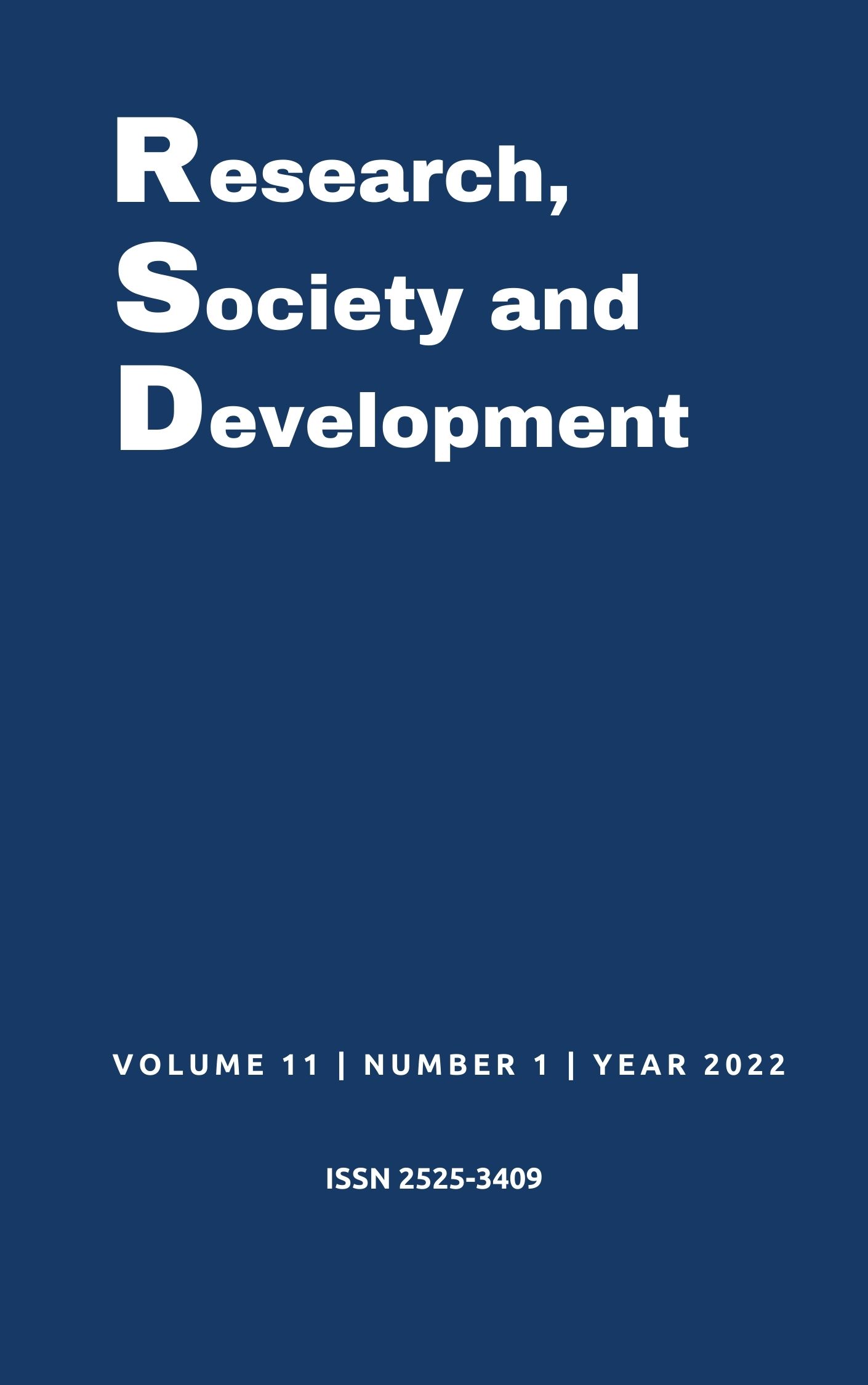Use of graphene and niobium in medical practice: a narrative literature review
DOI:
https://doi.org/10.33448/rsd-v11i1.25526Keywords:
Nanomaterials; Applications; Medicine; Niobium; Graphene.Abstract
Introduction: The so-called nanomaterials are considered by many, materials that have their structure restricted to dimensions from 1 to 100 nm. Nanomaterials have a wide range of applications in biomedicine, food and agriculture, drugs and vaccines, and especially in catalysis. Objective: to show the applications of graphene and niobium nanomaterials in medicine, highlighting their promising results in this field. Methodology: This is a descriptive research of the narrative literature review type. The search was carried out through online access in the National Library of Medicine (PubMed MEDLINE), Scientific Electronic Library Online (Scielo), Cochrane Database of Systematic Reviews (CDSR), Google Scholar, Virtual Health Library (BVS) and EBSCO databases Information Services, November 2021. Results and discussion: Reduced graphene oxide has been shown to be an excellent photothermal agent, allowing the efficient elimination of tumors in in vivo experiments, as well as, due to the excellent electrical conductivity of graphene, it promises to improve the conversion of synapses into motion. Furthermore, the use of niobium is growing in the medical field as an alloying element to increase the mechanical strength of biocompatible orthopedic implants. Final considerations: Thus, it is possible to say that there are many benefits that graphene and niobium, interconnected with nanotechnology, will generate to humanity, and especially to medical advances.
References
Alves, O. L. (2013). Nanotecnologias: Elas Já Estão Entre Nós. Revista Ciência e Cultura, 65 (3), 22-27.
Cavalcanti, R. M. et al. (2013). Characterization of ZSM-5 modified with niobium pentoxide: The study of thiophene adsorption. Journal of the Brazilian Chemical Society, 24 (1), 40–50.
Ferreira, H. S., et al. (2009). Nanotecnologia: Aspectos gerais e potencial de aplicação em catálise. Química Nova, 32 (7), 1860–1870.
Geim A. K., et al. (2007). The rise of graphene. Nature Mater, 6 (5), 183-191.
Geim, A. K. (2009). Graphene: status and prospects. Science, 324 (33), 1530 -1543.
Hu, M., et al. (2017). Graphene-Based Nanomaterials for Catalysis. Industrial and Engineering Chemistry Research, 56 (13), 3477–3502.
Jain, A. et al. (2018). Nanomaterials in food and agriculture: An overview on their safety concerns and regulatory issues. Critical Reviews in Food Science and Nutrition, 58 (2), 297–317.
Li, H., et al. (2011). Remarkable biocompatibility enhancement of porous NiTi alloys by a new surface modification approach: in-situ nitriding and in vitro and in vivo evaluation. J Biomed Mater Res., 99 (4), 544-553.
Lopes, O. F. et al. (2015). Óxidos de nióbio: Uma visão sobre a síntese do Nb2O5 e sua aplicação em fotocatálise heterogênea. Química Nova, 38 (1), 106–117.
Makvandi, P. et al. (2020). Metal-Based Nanomaterials in Biomedical Applications: Antimicrobial Activity and Cytotoxicity Aspects. Advanced Functional Materials, 30 (22), 1-8.
Maroli, C. (2021). Caracterização de nanoestruturas de óxido de nióbio para aplicação em fotocatálise heterogênea. TCC (graduação) - Universidade Federal de Santa Catarina. Centro de Ciências Físicas e Matemáticas. Curso de Química, 1-86.
Munroe, N., et al. (2009). Enhanced Biocompatibility of Porous Nitinol. J Mater Eng Perform., 18 (6), 765-767.
Novoselov, K.S. et al. (2012). A roadmap for graphene. Nature, 190 (5), 192-200.
Prado, N. T., et al. (2017). Nanostructured niobium oxide synthetized by a new route using hydrothermal treatment: High efficiency in oxidation reactions. Applied Catalysis B: Environmental, 205 (5), 481–488.
Pytlicek, Z. et al. (2019). On-chip sensor solution for hydrogen gas detection with the anodic niobium-oxide nanorod arrays. Sensors and Actuators, 284 (12), 723–735.
Santos, A. J. et al. (2019). Niobium oxide catalysts as emerging material for textile wastewater reuse: Photocatalytic decolorization of azo dyes. Catalysts, 9 (12), 56-70.
Shapira L., et al. (2020). Efeito de uma liga de titânio contendo nióbio no comportamento de osteoblastos em cultura. Pesquisa Clínica de Implantes Orais, 20 (6), 578-582.
Shareena, T. P. D et al. (2018). A Review on Graphene-Based Nanomaterials in Biomedical Applications and Risks in Environment and Health. Nano-Micro Letters, 10 (3), 1–34.
Stróz, A., et al. (2018). Electrochemical Formation of Self Organized Nanotubular Oxide Layers on Niobium (Review). Current Nanoscience, 15 (1), 42–48.
Tang, Z. et al. (2020). Phosphorus Science-Oriented Design and Synthesis of Multifunctional Nanomaterials for Biomedical Applications. Matter, 2 (2), 297– 322.
Toma, H. (2016). Nanotecnologia Molecular - Materiais e Dispositivos. Edgard Blü ed. 1-67.
Vasconcelos Y., et al. (2019). O polêmico nióbio. Revista Pesquisa FAPESP, 20 (277), 63–69.
Wang, X., et al. (2010). Biomimetic modification of porous TiNbZr alloy scaffold for bone tissue engineering. Tissue Eng Part., 56 (6) 309–316.
Downloads
Published
How to Cite
Issue
Section
License
Copyright (c) 2022 Bárbara Queiroz de Figueiredo; Álvaro Peixoto de Morais; Ana Clara Viana Soares Brito; Dieison Danrlei Roehrs; Heitor Laborão Carneiro; Isabelle Gomes de Sousa; Letícia de Oliveira Araújo; Lorena Martins Nagata; Lunalva Gabrielli Veras Sousa; Maria Jacilene de Araújo Gomes; Melina Fonseca Maia França Coury Alves

This work is licensed under a Creative Commons Attribution 4.0 International License.
Authors who publish with this journal agree to the following terms:
1) Authors retain copyright and grant the journal right of first publication with the work simultaneously licensed under a Creative Commons Attribution License that allows others to share the work with an acknowledgement of the work's authorship and initial publication in this journal.
2) Authors are able to enter into separate, additional contractual arrangements for the non-exclusive distribution of the journal's published version of the work (e.g., post it to an institutional repository or publish it in a book), with an acknowledgement of its initial publication in this journal.
3) Authors are permitted and encouraged to post their work online (e.g., in institutional repositories or on their website) prior to and during the submission process, as it can lead to productive exchanges, as well as earlier and greater citation of published work.

